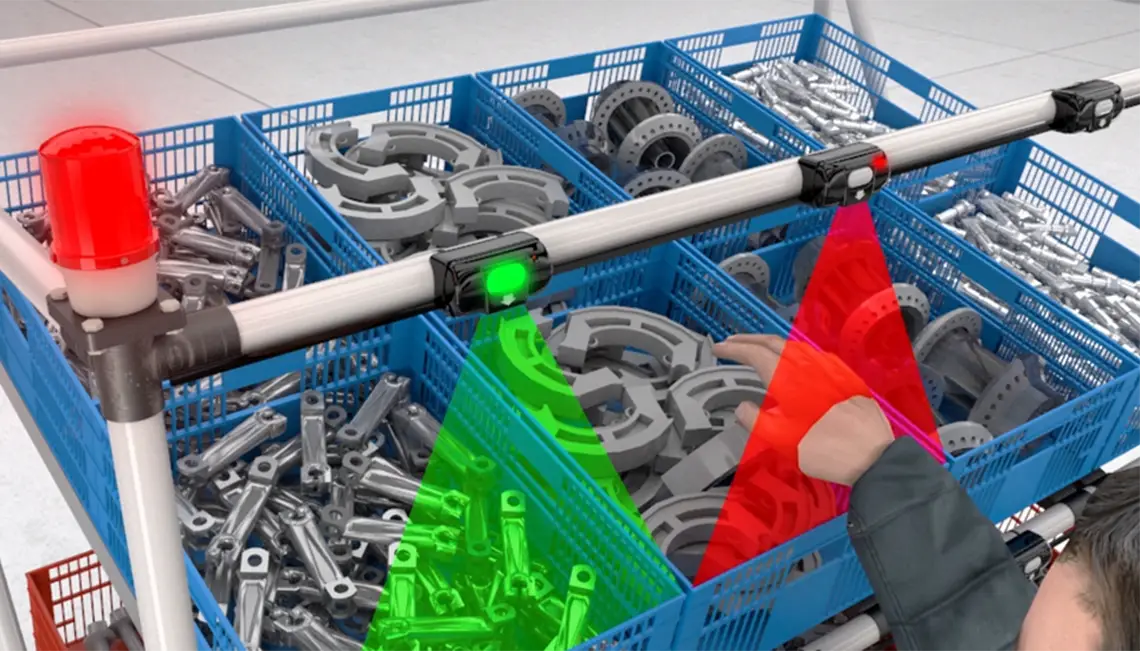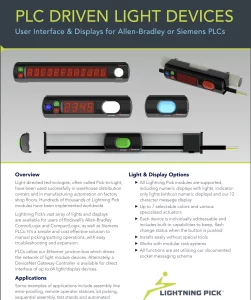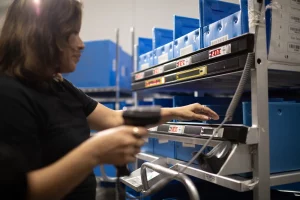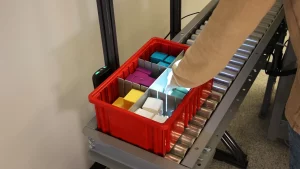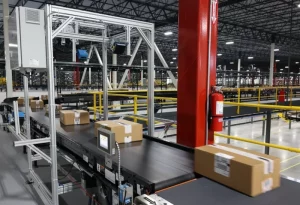Pick-to-Light for Manufacturing – Part 2: Controlling Lights with PLCs
This post is the second in a series about pick-to-light systems for manufacturing operations. Part 1 of the series introduces how pick-to-light systems work and a list of applications they can improve, including a video demonstrating light-directed picking, kitting, and assembly.
Pick-to-Light Control Methodologies
Matthews’ Lightning Pick hardware platform can communicate within automation ecosystems managed by software on Windows servers, programmable logic controllers (PLCs) or environments utilizing combinations of both. Hundreds of thousands of Lightning Pick light modules have been deployed in distribution, fulfillment, and manufacturing facilities worldwide to help employees execute material handling tasks with impactful applications throughout the supply chain. Below are descriptions of each of the main methodologies: software and PLCs.
Pick-to-Light Systems Managed by Software
In 1998, Lightning Pick was launched as the first Windows-based pick-to-light solution in North America, freeing the technology from the expensive mainframes and large IT departments needed to develop and support previous generations. This approach encouraged the adoption of light-directed systems by a larger range of company types and sizes, in a broadening range of industries, to be effectively applied across a growing span of fulfillment processes in their omnichannel operations. Today global brands have scaled this Lightning Pick platform into enterprise class systems deployed throughout multiple sites in their supply chains. Today, Lightning Pick software offers cloud-enabled applications and dashboards in tandem with emerging industry IT standards.
For this strategy, Lightning Pick software integrates to the customer’s manufacturing execution systems (MES), warehouse execution systems (WES), warehouse management systems, enterprise resource planning (ERP) and other host software to receive orders, bills of materials (BOMs) and other information required to execute the next wave of work. The Lightning Pick software provides functionality including system configuration, order management, labor management, real-time process visibility with productivity KPIs and dashboards to optimize the light-directed execution of work. The server sends instructions to the Ethernet Junction Box (EJB) which provides power and data to light modules through a twin-wire cable enclosed in the aluminum duct or other mounting media.
Software-based pick-to-light has excelled in applications requiring direct interface with the customer’s host software and executes more complex or dynamic material handling processes.
While both manufacturers and distributors often use some combination of PCs and PLCs to manage facility automation, today software-based pick-to-light like Lightning Pick is the common platform for DCs and fulfillment centers. A software interface to the customer’s WMS or WES and more robust picking software is advantageous with their constant flow of small, unique customer orders like ecommerce.

Pick-to-Light Systems Managed by PLCs
In factories, PLCs are often the preferred method of controlling industrial automation. It’s not surprising, as PLCs are special-purpose computers that have a simple and rugged design ideal for busy locations. They’re capable of handling complicated operations yet are relatively easy to modify. Plus, they’re modular for straightforward maintenance and expansion.
This environment is advantageous as PLCs easily integrate with many types of equipment including supervisory control and data acquisition (SCADA), human machine interfaces (HMI), sensors and more. As such they provide real-time data collection and drive many Smart Factory initiatives like the Internet of Things (IoT), robotics, machine learning and other process improvement tools. Lightning Pick integrates into the PLC ecosystem as an effective poka-yoke or mistake-proofing solution for build-to-order manufacturers leveraging visual tools for quality initiatives. Some popular applications are assembly line error-proofing, kit packing, remote operator stations, test stands, sequential assembly and annotating automated sortation chutes.
Lightning Pick is available for users of Rockwell’s Allen-Bradley ControlLogix and CompactLogix, as well as Siemens PLCs. The PLCs can control the network of light displays directly by using Lightning Pick’s Ethernet junction box which delivers data and power through the Twin Wire (TW) cable system. The PLCs can control larger systems using an Ethernet controller that supports multiple junction boxes and connects over 5,000 lights. Smaller systems can use mini-controller EJBs where each supports a single channel with approximately 20 devices.
Or the PLCs can use DeviceNet Gateway Controllers for direct interface of up to 64 light/display devices. More gateways can be added to expand systems to those standards. Either method utilizes Matthews’ documented socket messaging schema to set functionality and supports all Lightning Pick modules.
Download the PLC Driven Light Devices data sheet to learn more about the light and display options, features and functionality that can be controlled with this method.
- Browse by category: Blog, Lightning Pick, News, Products
Data Sheet – PLC Driven Light Devices
Learn more about the light and display options, features and functionality.
Learn what our systems can do for your operation.

